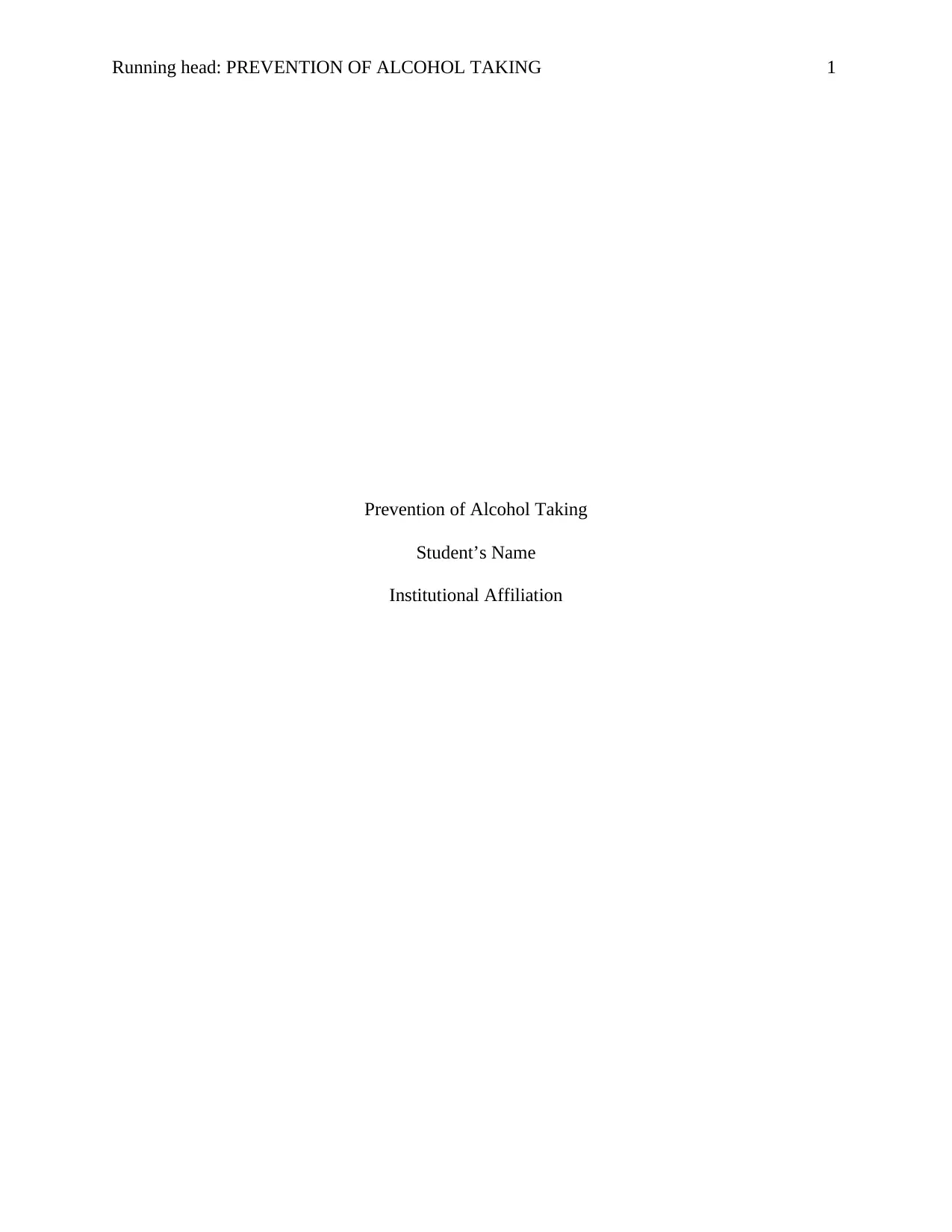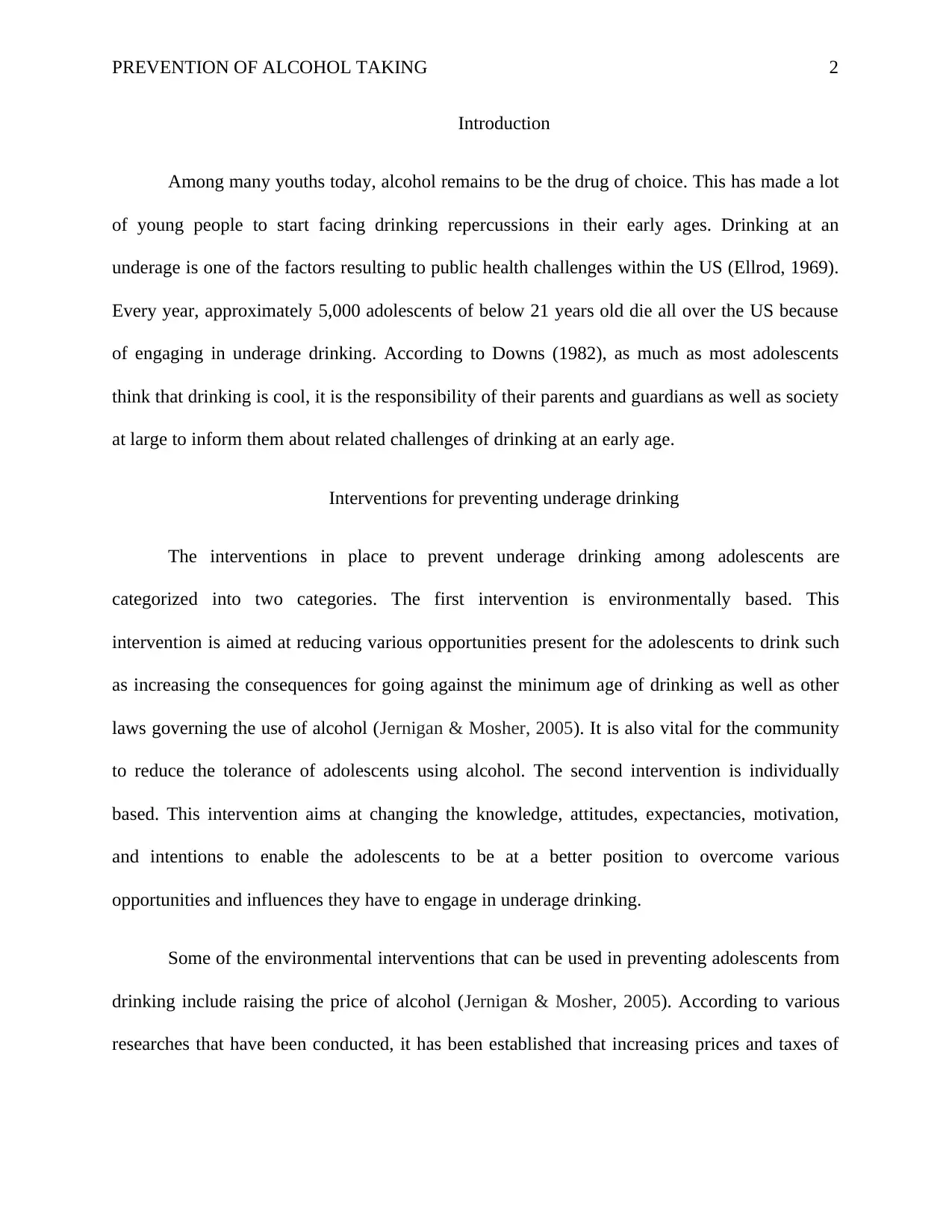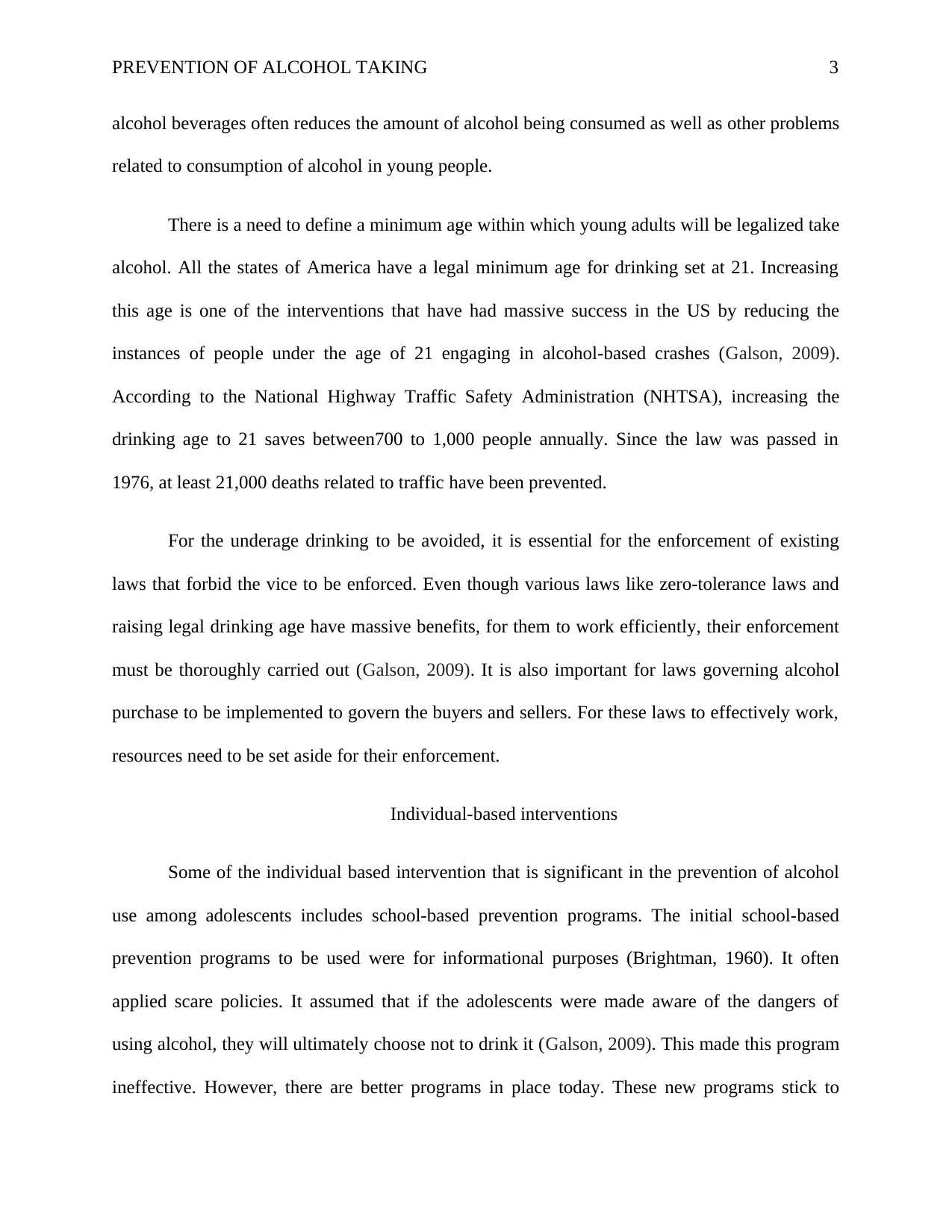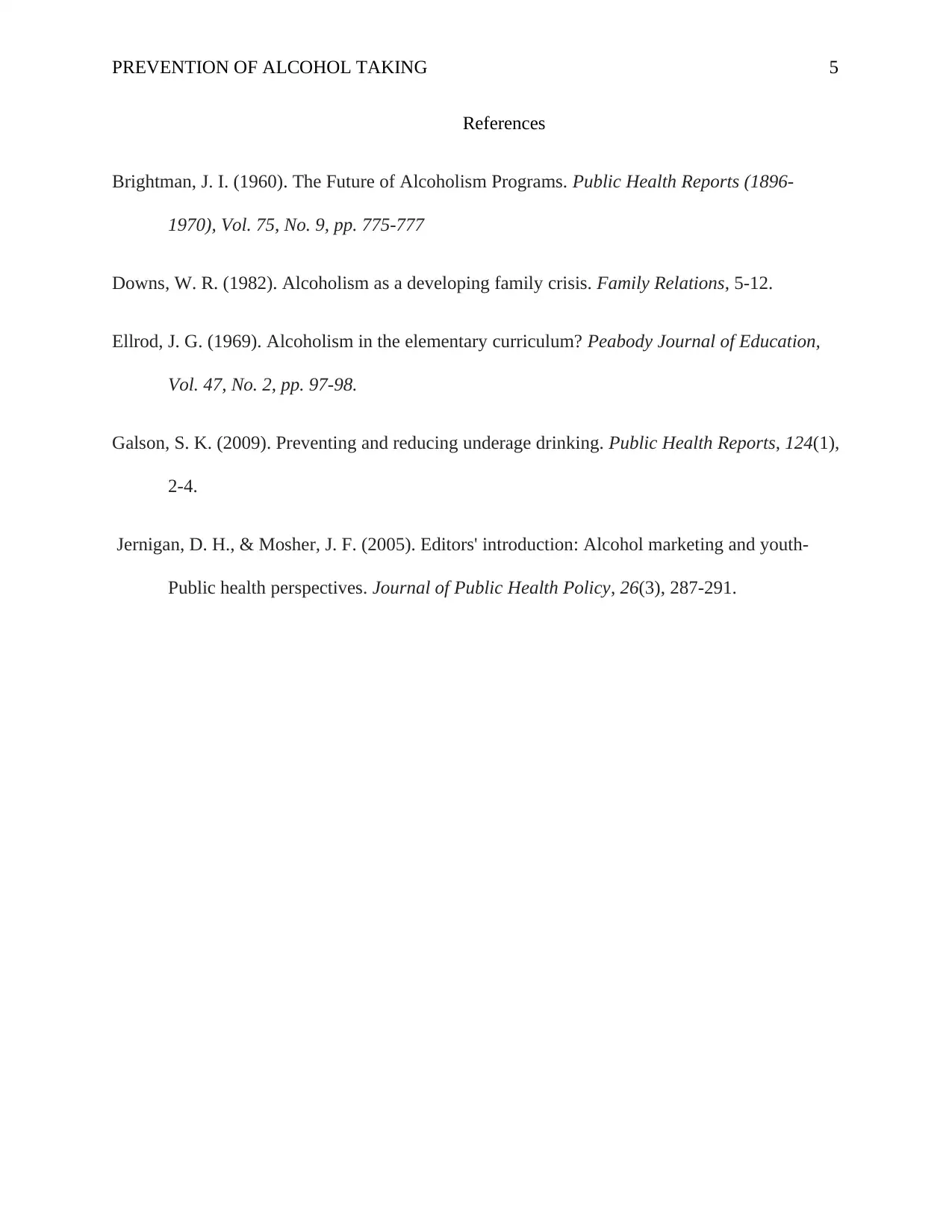Prevention of Alcohol Taking Assignment 2022
VerifiedAdded on 2022/10/17
|5
|997
|8
Assignment
AI Summary
Contribute Materials
Your contribution can guide someone’s learning journey. Share your
documents today.

Running head: PREVENTION OF ALCOHOL TAKING 1
Prevention of Alcohol Taking
Student’s Name
Institutional Affiliation
Prevention of Alcohol Taking
Student’s Name
Institutional Affiliation
Secure Best Marks with AI Grader
Need help grading? Try our AI Grader for instant feedback on your assignments.

PREVENTION OF ALCOHOL TAKING 2
Introduction
Among many youths today, alcohol remains to be the drug of choice. This has made a lot
of young people to start facing drinking repercussions in their early ages. Drinking at an
underage is one of the factors resulting to public health challenges within the US (Ellrod, 1969).
Every year, approximately 5,000 adolescents of below 21 years old die all over the US because
of engaging in underage drinking. According to Downs (1982), as much as most adolescents
think that drinking is cool, it is the responsibility of their parents and guardians as well as society
at large to inform them about related challenges of drinking at an early age.
Interventions for preventing underage drinking
The interventions in place to prevent underage drinking among adolescents are
categorized into two categories. The first intervention is environmentally based. This
intervention is aimed at reducing various opportunities present for the adolescents to drink such
as increasing the consequences for going against the minimum age of drinking as well as other
laws governing the use of alcohol (Jernigan & Mosher, 2005). It is also vital for the community
to reduce the tolerance of adolescents using alcohol. The second intervention is individually
based. This intervention aims at changing the knowledge, attitudes, expectancies, motivation,
and intentions to enable the adolescents to be at a better position to overcome various
opportunities and influences they have to engage in underage drinking.
Some of the environmental interventions that can be used in preventing adolescents from
drinking include raising the price of alcohol (Jernigan & Mosher, 2005). According to various
researches that have been conducted, it has been established that increasing prices and taxes of
Introduction
Among many youths today, alcohol remains to be the drug of choice. This has made a lot
of young people to start facing drinking repercussions in their early ages. Drinking at an
underage is one of the factors resulting to public health challenges within the US (Ellrod, 1969).
Every year, approximately 5,000 adolescents of below 21 years old die all over the US because
of engaging in underage drinking. According to Downs (1982), as much as most adolescents
think that drinking is cool, it is the responsibility of their parents and guardians as well as society
at large to inform them about related challenges of drinking at an early age.
Interventions for preventing underage drinking
The interventions in place to prevent underage drinking among adolescents are
categorized into two categories. The first intervention is environmentally based. This
intervention is aimed at reducing various opportunities present for the adolescents to drink such
as increasing the consequences for going against the minimum age of drinking as well as other
laws governing the use of alcohol (Jernigan & Mosher, 2005). It is also vital for the community
to reduce the tolerance of adolescents using alcohol. The second intervention is individually
based. This intervention aims at changing the knowledge, attitudes, expectancies, motivation,
and intentions to enable the adolescents to be at a better position to overcome various
opportunities and influences they have to engage in underage drinking.
Some of the environmental interventions that can be used in preventing adolescents from
drinking include raising the price of alcohol (Jernigan & Mosher, 2005). According to various
researches that have been conducted, it has been established that increasing prices and taxes of

PREVENTION OF ALCOHOL TAKING 3
alcohol beverages often reduces the amount of alcohol being consumed as well as other problems
related to consumption of alcohol in young people.
There is a need to define a minimum age within which young adults will be legalized take
alcohol. All the states of America have a legal minimum age for drinking set at 21. Increasing
this age is one of the interventions that have had massive success in the US by reducing the
instances of people under the age of 21 engaging in alcohol-based crashes (Galson, 2009).
According to the National Highway Traffic Safety Administration (NHTSA), increasing the
drinking age to 21 saves between700 to 1,000 people annually. Since the law was passed in
1976, at least 21,000 deaths related to traffic have been prevented.
For the underage drinking to be avoided, it is essential for the enforcement of existing
laws that forbid the vice to be enforced. Even though various laws like zero-tolerance laws and
raising legal drinking age have massive benefits, for them to work efficiently, their enforcement
must be thoroughly carried out (Galson, 2009). It is also important for laws governing alcohol
purchase to be implemented to govern the buyers and sellers. For these laws to effectively work,
resources need to be set aside for their enforcement.
Individual-based interventions
Some of the individual based intervention that is significant in the prevention of alcohol
use among adolescents includes school-based prevention programs. The initial school-based
prevention programs to be used were for informational purposes (Brightman, 1960). It often
applied scare policies. It assumed that if the adolescents were made aware of the dangers of
using alcohol, they will ultimately choose not to drink it (Galson, 2009). This made this program
ineffective. However, there are better programs in place today. These new programs stick to
alcohol beverages often reduces the amount of alcohol being consumed as well as other problems
related to consumption of alcohol in young people.
There is a need to define a minimum age within which young adults will be legalized take
alcohol. All the states of America have a legal minimum age for drinking set at 21. Increasing
this age is one of the interventions that have had massive success in the US by reducing the
instances of people under the age of 21 engaging in alcohol-based crashes (Galson, 2009).
According to the National Highway Traffic Safety Administration (NHTSA), increasing the
drinking age to 21 saves between700 to 1,000 people annually. Since the law was passed in
1976, at least 21,000 deaths related to traffic have been prevented.
For the underage drinking to be avoided, it is essential for the enforcement of existing
laws that forbid the vice to be enforced. Even though various laws like zero-tolerance laws and
raising legal drinking age have massive benefits, for them to work efficiently, their enforcement
must be thoroughly carried out (Galson, 2009). It is also important for laws governing alcohol
purchase to be implemented to govern the buyers and sellers. For these laws to effectively work,
resources need to be set aside for their enforcement.
Individual-based interventions
Some of the individual based intervention that is significant in the prevention of alcohol
use among adolescents includes school-based prevention programs. The initial school-based
prevention programs to be used were for informational purposes (Brightman, 1960). It often
applied scare policies. It assumed that if the adolescents were made aware of the dangers of
using alcohol, they will ultimately choose not to drink it (Galson, 2009). This made this program
ineffective. However, there are better programs in place today. These new programs stick to

PREVENTION OF ALCOHOL TAKING 4
models of social influence by minimizing existing social pressure to take alcohol as well as
training the adolescents' resistance skills.
Family-based prevention programs are also important. This is because parents often play
a vital role in determining whether or not their children will drink (Jernigan & Mosher, 2005).
Parents need to have rules in place that forbid drinking and ensure that the rules are enforced
while constantly monitoring the children's behavior to reduce their likelihood of engaging in
underage drinking.
In conclusion, we are leaving in a world where alcohol is broadly available and it is being
promoted all over society. The consumption of alcohol is regarded by several people to be a
normal part of growth. Underage drinking remains to be dangerous both for the drinkers and the
society at large. Drinking at an early age leads to higher risks of getting drinking-related
challenges in later life. This is why it is essential for drinking adolescents to be identified and
helped to avoid developing a drinking problem.
models of social influence by minimizing existing social pressure to take alcohol as well as
training the adolescents' resistance skills.
Family-based prevention programs are also important. This is because parents often play
a vital role in determining whether or not their children will drink (Jernigan & Mosher, 2005).
Parents need to have rules in place that forbid drinking and ensure that the rules are enforced
while constantly monitoring the children's behavior to reduce their likelihood of engaging in
underage drinking.
In conclusion, we are leaving in a world where alcohol is broadly available and it is being
promoted all over society. The consumption of alcohol is regarded by several people to be a
normal part of growth. Underage drinking remains to be dangerous both for the drinkers and the
society at large. Drinking at an early age leads to higher risks of getting drinking-related
challenges in later life. This is why it is essential for drinking adolescents to be identified and
helped to avoid developing a drinking problem.
Paraphrase This Document
Need a fresh take? Get an instant paraphrase of this document with our AI Paraphraser

PREVENTION OF ALCOHOL TAKING 5
References
Brightman, J. I. (1960). The Future of Alcoholism Programs. Public Health Reports (1896-
1970), Vol. 75, No. 9, pp. 775-777
Downs, W. R. (1982). Alcoholism as a developing family crisis. Family Relations, 5-12.
Ellrod, J. G. (1969). Alcoholism in the elementary curriculum? Peabody Journal of Education,
Vol. 47, No. 2, pp. 97-98.
Galson, S. K. (2009). Preventing and reducing underage drinking. Public Health Reports, 124(1),
2-4.
Jernigan, D. H., & Mosher, J. F. (2005). Editors' introduction: Alcohol marketing and youth-
Public health perspectives. Journal of Public Health Policy, 26(3), 287-291.
References
Brightman, J. I. (1960). The Future of Alcoholism Programs. Public Health Reports (1896-
1970), Vol. 75, No. 9, pp. 775-777
Downs, W. R. (1982). Alcoholism as a developing family crisis. Family Relations, 5-12.
Ellrod, J. G. (1969). Alcoholism in the elementary curriculum? Peabody Journal of Education,
Vol. 47, No. 2, pp. 97-98.
Galson, S. K. (2009). Preventing and reducing underage drinking. Public Health Reports, 124(1),
2-4.
Jernigan, D. H., & Mosher, J. F. (2005). Editors' introduction: Alcohol marketing and youth-
Public health perspectives. Journal of Public Health Policy, 26(3), 287-291.
1 out of 5
![[object Object]](/_next/static/media/star-bottom.7253800d.svg)